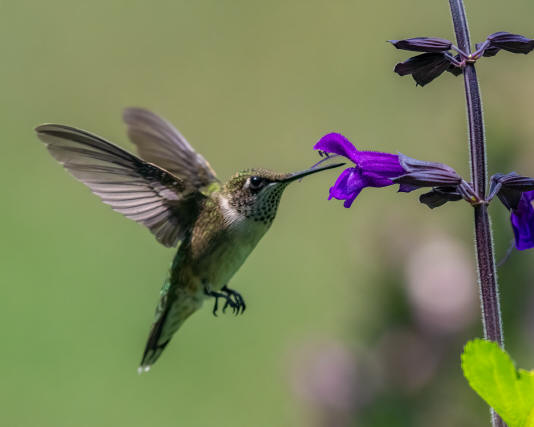(5/15) The mystical lifestyle of hummingbirds can be enjoyed in your garden by learning how to provide an environment for them. Hummers provide entertainment for bird-watchers and are a photographer’s delight. It is crucial to work hard to attract hummingbirds to your garden environment because they have a spatial memory and once they become established, they will come back again the following year.

Ruby-throated hummingbirds are the only hummingbirds east of the Mississippi River. Hummingbirds are named for the prominent humming sound their wings make while flying and hovering to feed or interact with other hummingbirds.
Male Ruby-throated hummingbirds are identifiable by their bright, emerald green backs, white breasts, and incandescent red gorgets (throats) that make them appear like flying jewels. Female hummingbirds have white throats with occasional faint tan streaking. Juvenile male and female hummingbirds look similar. Males will usually get their full red gorgets during their first winter of existence.
Hummingbird feeders supplement their nutrition when there is no nectar from flowers to sustain them. Place a hummingbird feeder outside in mid-April and fill it with a mixture of four parts previously boiled water and one part white sugar to welcome hummingbirds to your garden. Be sure that the sugar water gets changed every four to five days. The feeders should be at least four feet above the ground so they are beyond the reach of cats and other predators. Ideally they should be placed in strategic viewing areas for your entertainment. Annually we have a contest at our home to determine who witnesses the first appearance of a hummingbird. Our unscientific earliest hummingbird sighting was on April 22.
Male hummingbirds will mate with more than one female. The females build their nests five to twenty feet above the ground. Their nests are the size of a walnut and are usually found in deciduous trees located near a water source and in areas that will provide protection. Females return each year to the same areas and may reuse the old nests.
Female hummingbirds typically lay two pea-shaped eggs. They incubate the eggs and raise the young without the assistance of the males. They find locations near nectar and insects because they chew up insects, combine them with nectar, and deposit the mixture into the mouths of the baby hummingbirds. The average lifespan of a hummingbird is 3-5 years.
Ruby-throated hummingbirds weigh approximately one-ninth of an ounce. In comparison, this would be less than the weight of a nickel. Hummingbirds at rest breathe four times per second and their hearts beat 20 times per second. Hummingbirds can beat their wings up to 70 times per second. They are territorial because their instinct is to guard their food source. Hummers are the only birds that can fly backward, forward, and straight up and down as well as hover. They have the highest metabolic rate of all vertebrate animals. At night when not foraging, they can enter torpor, a state similar to hibernation, and slow their metabolic rate to 1/5 its normal rate. This enables them to conserve energy when food is scarce.
Flowering plants and hummingbirds complement each other because plants provide nectar and hummingbirds provide pollination. No other birds feed on nectar as consistently as hummingbirds. These amazing birds are able to consume half their weight in food every day. Their long beaks and elongated tongues easily consume nectar from flowers. When the hummers feed on the nectar, the pollen sticks to their beaks. When they go to the next flower, they transfer some of the pollen to that flower. Hummingbirds do not have a keen sense of smell, so they are attracted to flowers with a particular hue and tubular shape. Their color preferences are red, pink, blue, purple, and orange, and they prefer native plants. Avoid using any pesticides or insecticides. These chemicals can be harmful to the hummingbirds; they also kill the insects that are an important source of hummingbird food.
With careful planning, you can provide a food source for hummingbirds from spring to fall. Some springtime plants that are magnets for hummingbirds are Columbine (Aquilegia), which comes in a variety of colors, Bleeding Heart (Dicentra), and Virginia Bluebell (Mertensia Virginica). In the summer, hummingbirds cannot resist Crocosmia, Phlox, and Bee Balm (Monarda). Other summer-blooming flowers that attract hummingbirds are Verbena, Hollyhocks (Alcea), Heuchera, Penstemon, and Salvia, which depending on the variety, can be a perennial or an annual. Crocosmia have been the favorite blooms for the hummingbirds in our garden. Cardinal flower (Lobelia Cardinalis), Lantana, Salvia, Canna Lilies, and Milkweed (Asclepias Tuberosa) provide nectar-rich blooms in summer and early fall.
Each fall our hummingbird friends leave Pennsylvania and migrate between southern Mexico and northern Panama. They know when it is time to migrate by the change in the length of daylight. They need to feed constantly and build up their fat reserves before migrating because they use much energy during their long journey. During their migration, they fly nonstop 600 miles across the Gulf of Mexico to get to their destination.
Keep feeders outside until the beginning of October so these wonderful birds can store enough energy to successfully migrate south. You might have visiting hummingbirds from the north stopping at your feeder on their journey south. The Ruby-throats begin migrating north as early as January. Once in North America, migration proceeds at an average rate of twenty miles a day.
Birdwatchers and gardeners who understand how to attract hummingbirds by satisfying their need for food, water, shelter, and nesting spots will be rewarded with hummingbirds in their backyard for many years.
"Oh, tiny living lightning, when you hover in the air you are a body of pollen." From Ode to the Hummingbird by Pablo Neruda.